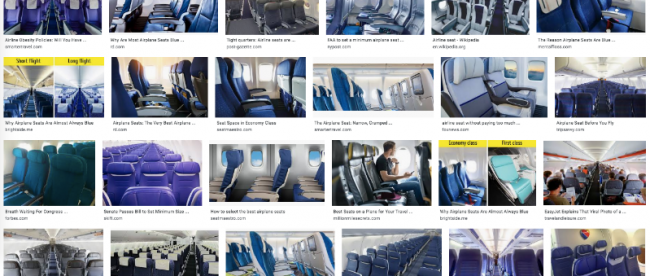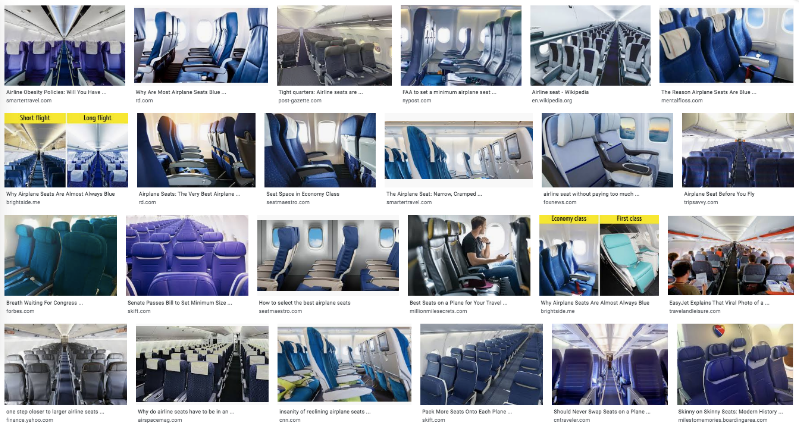The Color of Flying Calmly


Pictured above is a Google Image Search of the phrase “airline seats.” While the selection of 24 images is hardly selected at random — who knows how Google’s algorithms work? — it’s probably a good-enough approximation of what a “typical” airplane seat looks like. And you may notice something common in most of the pictures: blue seats.
It’s not a coincidence. It’s by design.
For many, flying is an anxiety-inducing experience. And the airlines don’t often make it less stressful. You have to arrive well before your flight departs, stand in a security line, take off your shoes, turn over any bottles of liquid larger than the allowed limits, etc. Then you get to sit around at the gate in often-uncomfortable accommodations hoping there are no flight delays. If all goes right, you get to board the plane in a chaotic fashion, wait on the runway for takeoff — and that’s when the actually nerve-wracking part begins.
But while it may not be obvious, airlines would prefer that their customers aren’t nervous. And that’s something they consider when it comes to what you see when you’re seated for your flight. Nigel Goode, an aviation designer, explained to the Telegraph that when it comes to the interiors of commercial aircraft, “[the] primary concern is to deliver an interior that maximizes comfort to create a pleasant environment.” And while we’d all love more legroom or lie-flat seats for longer flights, that’s not always an option.
But interior design can make a difference. Aircraft manufacturer Boeing, in a press release, explained their approach to the cabin: “the idea is to give airplanes a more residential feeling, with relaxing colors and restful designs.” And as Goode explains, when it comes to colors, blue seats are the way to go: “It’s all about making the traveling experience less stressful and blue is said to evoke a feeling of calm,” an opinion echoed by Psychology Today. (Conversely, as the New York Post reports, “in the 1970s and 80s, there was a trend for airlines to install red seats in cabins but they were later removed, in part because warm colors are thought to spark hostile and angry emotions in passengers.)
Of course, for the most nervous of flyers, seat color isn’t going to make that much of a difference. If you still need some tactical advice, the Anxiety and Depression Association of America has eight tips you may want to try, here.
Bonus fact: While the seats may help keep you calm, there’s no accounting for the actions of other passengers. In extreme cases, an out of control passenger may lead the flight crew to divert from the scheduled flight path and land early. And at least once, bad singing constituted such a situation. In 2013, the New York Post reported that “an American Airlines jet headed to Kennedy Airport from LA was forced to make an emergency landing in Kansas City after a woman refused to stop belting out Whitney Houston’s ‘I Will Always Love You.'” You can judge for yourself if the singing warranted such a response; another passenger recorded her being ejected from the plane, as seen here. (You won’t hear her sing until the end.)
From the Archives: The Shape of Safety: Why airplane windows are oval (and, in the bonus fact, why they have little holes).
